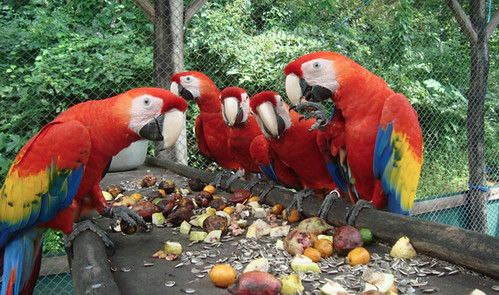 Once abundant in the Nicoya Peninsula, the Ara Macaw (lapa roja) population has decreased over the years, but efforts are now being made to help the macaws recover.
Once abundant in the Nicoya Peninsula, the Ara Macaw (lapa roja) population has decreased over the years, but efforts are now being made to help the macaws recover.
Nelson Marin Mora, director of the Tempisque Conservation Area with Minaet in Nicoya, said there are now very few macaws in the peninsula, primarily because people have captured the vibrantly colorful birds to sell as pets. However, Marin assured that the new Wildlife Conservation Law will help since it carries very strict penalties, with fines of up to 1.2 million colones ($2400) for anyone who has wildlife in captivity without authorization.
“It’s more beautiful for them to be in their natural state,” Marin said. “Seeing them in a cage is very ugly.”
A couple of macaws have been observed around Bolsón of Santa Cruz, Marin informed. Another area where native macaws can still be found is in the area between Barra Honda and Palo Verde National Parks. In Barra Honda, a project to care for the macaws was established when a nest was found, with people looking after the nest for months until the babies hatched and were freed.
Additionally, a macaw liberation site has been established in Barcelo near Tambor, and about a year ago, the Ara Project introduced macaws in Punta Islita, fitted with identification rings and chips. The birds were acclimatized and conditioned to the area before release and a study was conducted on the macaw’s local diet. Marin related that their diet includes beach almonds, nances and wild jocotes, among others.
Chris Castles, co-director of the Ara Project, related that in Punta Islita, they released 10 macaws last year (five pairs), of which 7 individuals were successfully established. Three disappeared. A second release of macaws is planned for February.
The Ara Project is also looking to move their breeding center from Alajuela to Punta Islita. “The people at Punta Islita have donated to the project 2½ hectares of land for us to move to and call our permanent new home,” Castles said.
Environmental education has also been conducted in the schools around Barra Honda and Punta Islita to encourage everyone in the area to protect the macaws. Marin said that environmental education is one of the most important components of the projects.
Looking to the future, Marin said they would like to establish a protection project in another sector between Nicoya and Santa Cruz so that later the different macaw populations can have a genetic interchange. However, establishing a project requires identifying a good property as well as organizational and economic backing.
If you would like more information about the Ara Project in Punta Islita or would like to donate funds or construction materials to help build a breeding center there, contact info@thearaproject.org or visit www.thearaproject.org.